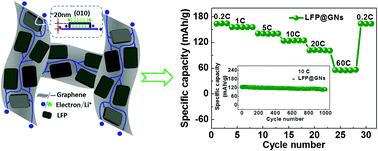Desired crystal oriented LiFePO4 nanoplatelets in situ anchored on a graphene cross-linked conductive network for fast lithium storage†
Abstract
Electron transfer and lithium ion diffusion rates are the key factors limiting the lithium ion storage in anisotropic LiFePO4 electrodes. In this work, we employed a facile solvothermal method to synthesize a “platelet-on-sheet” LiFePO4/graphene composite (LFP@GNs), which is LiFePO4 nanoplatelets in situ grown on graphene sheets with highly oriented (010) facets of LiFePO4 crystals. Such a two-phase contact mode with graphene sheets cross-linked to form a three-dimensional porous network is favourable for both fast lithium ion and electron transports. As a result, the designed LFP@GNs displayed a high rate capability (∼56 mA h g−1 at 60 C) and long life cycling stability (∼87% capacity retention over 1000 cycles at 10 C). For comparison purposes, samples ex situ modified with graphene (LFP/GNs) as well as pure LiFePO4 platelets (LFP) were also prepared and investigated. More importantly, the obtained LFP@GNs can be used as a basic unit for constructing more complex structures to further improve electrochemical performance, such as coating the exposed LFP surface with a thin layer of carbon to build a C@LFP@GN composite to further enhance its cycling stability (∼98% capacity retention over 1000 cycles at 10 C).


 Please wait while we load your content...
Please wait while we load your content...